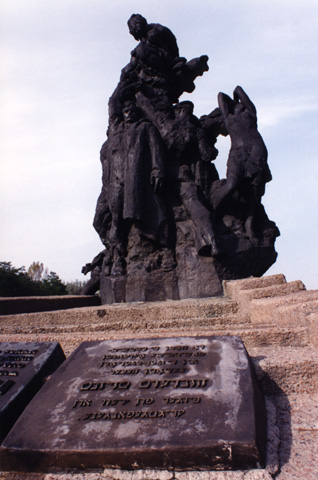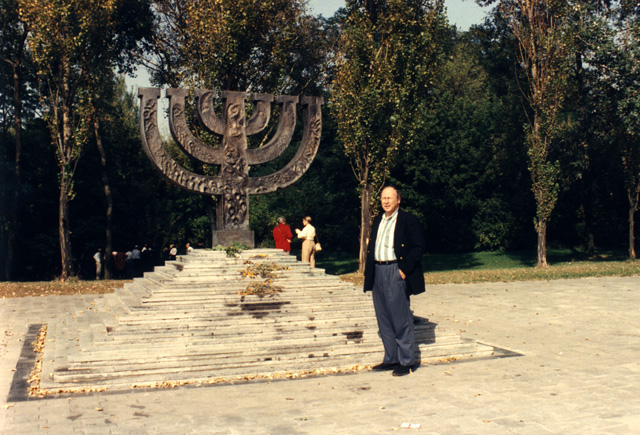
The Soviets erected this monument to martyred Soviet citizens at Babi Yar in 1976.
Babi Yar
Babi Yar is a deep and wide ravine located in Syrets, a suburb northwest of
Kiev. On September 29 and 30, 1941, it became the site for the mass murder of
33,751 Jewish men, women, and children from Kiev.
The Nazis claimed the killings were in response to a series of bombings in Kiev.
Ten days prior to the slaughter, the German army had defeated the Soviets forces
defending the city. Before fleeing, some of the Soviet fighters placed time
bombs in buildings that they thought the Germans would occupy. Five days later
the first of the explosives detonated, this one in the building housing the
headquarters of the German army. Over the next four days more bombs exploded and
many Germans were killed or injured.
The Nazi leadership decided that the appropriate retaliation would be the
extermination of Kiev’s Jewish population. So they posted notices on September
28, ordering all the Jews of Kiev to assemble near the cemetery. Most of the
Jews believed that they were being deported and would be transported by train to
another locality.
After the Jews assembled, they were forced to march to Babi Yar. Only as they
neared the ravine did they discover their true fate. By this time it was too
late to escape. Not far from the edge of the ravine, they were herded in small
groups into a narrow corridor formed by club-wielding soldiers on each side. The
soldiers beat the Jews mercilessly as they passed by. The Jews exited into an
area delineated by barbed wire and guarded by Ukrainian collaborators.
The Jews were ordered to remove their valuables and strip off their clothing.
Then they were beaten with sticks, and in small groups led naked down into the
ravine. The first groups of men, women, and children were forced to lie face
down on the ground and then Germans manning machine guns sprayed them with
bullets. A thin layer of dirt was thrown over the bodies and subsequent groups
of Jews were forced to lie atop the dead. They were similarly gunned down. A few
people survived their wounds and under the cover of darkness managed to crawl
out and hide.
The killing did not end with this massacre. The Nazis rounded up tens of
thousands of people, mostly Jews, from elsewhere in Ukraine and sent them to
Babi Yar to die. The shootings took place for months. According to David Budnik:
“The location and geography of Babi Yar was conducive to the German plans. The
slopes were steep and in some places even vertical. A direct road ran from here
to the center of the city. The residential area was separated from the ravine by
a prison and a [large Jewish] cemetery, so there would be no witnesses to the
mass murder. Here they shot partisans, members of the underground, Communists,
members of the Komsomol, Red Army soldiers, railway workers, members of the
military. They shot the sailors from the Dnieper fleet. They shot Ukrainians,
Russians, Jews, Poles [and Gypsies]. They shot anybody they deemed necessary,
systematically, and deliberately.”
Soviet officials later estimated that the fascists killed 100,000 people at Babi
Yar. David Budnik gives the number as 120,000 in his book. The majority of the
victims were Jewish.
The Germans set up a concentration camp at Syrets near Babi Yar so they would
have a slave labor force at their disposal. These prisoners typically survived a
few weeks before they too were murdered. The Nazis did not want to leave behind
eyewitnesses.
By July 1943, the tides of war had changed. The Soviet Army was advancing
westward toward Kiev and the Germans knew they would soon have to retreat. They
decided to destroy the evidence of the mass killings at Babi Yar. More than 300
prisoners from the concentration camp were forced to exhume the corpses and burn
them. However before the corpses were incinerated, a designated group of
prisoners stripped the corpses of any gold rings and earrings and removed the
gold teeth (in that era dentists had commonly used gold to repair or replace
decayed teeth).
The bodies were burned in crematoria constructed from railway rails, and
gravestones and iron fencing taken from the Jewish cemetery. Trees chopped down
from the cemetery served as fuel to get the fires going. Each furnace could burn
2,500 to 3,000 bodies at a time. After the bodies were burned, another team of
prisoners crushed the large pieces of bone remaining. The crushed bone and ash
was then mixed with sand and scattered on the road.
The gruesome task took six weeks to complete and the prisoners, knowing they
would be killed when they finished, planned an escape. During the break out and
the subsequent hunt for escapees, all but 14 of the 327 prisoners perished.
David Budnik, the man Paul Gass met in Kiev, was one of the survivors.
Three decades passed before the Soviet government erected a memorial at Babi
Yar. Finally in 1976, a monument was built. The inscription on the bronze plaque
dedicates the memorial to the Soviet citizens, war captives, soldiers, and
officers of the Soviet Army shot down by the German fascists at Babi Yar. It
makes no mention of Jewish victims. Finally in 1991 a bronze menorah was added
to commemorate Jewish martyrs.
|
|
|
The Soviets erected this monument to martyred Soviet citizens at Babi Yar in 1976. |
 |
|
In 1991, a menorah-shaped monument was dedicated in memory of the Jews who perished at Babi Yar. |
For more information about Babi Yar, you can read these eyewitness accounts:
Nothing Is Forgotten by David Budnik, edited by Roy Wiehn (Konstanz, Germany:
Hartung-Gorre Verlag, 1993).
Babi Yar by A. Anatoli (Kuznetsov), translated by David Floyd (New York: Farrar,
Straus & Giroux, 1970).